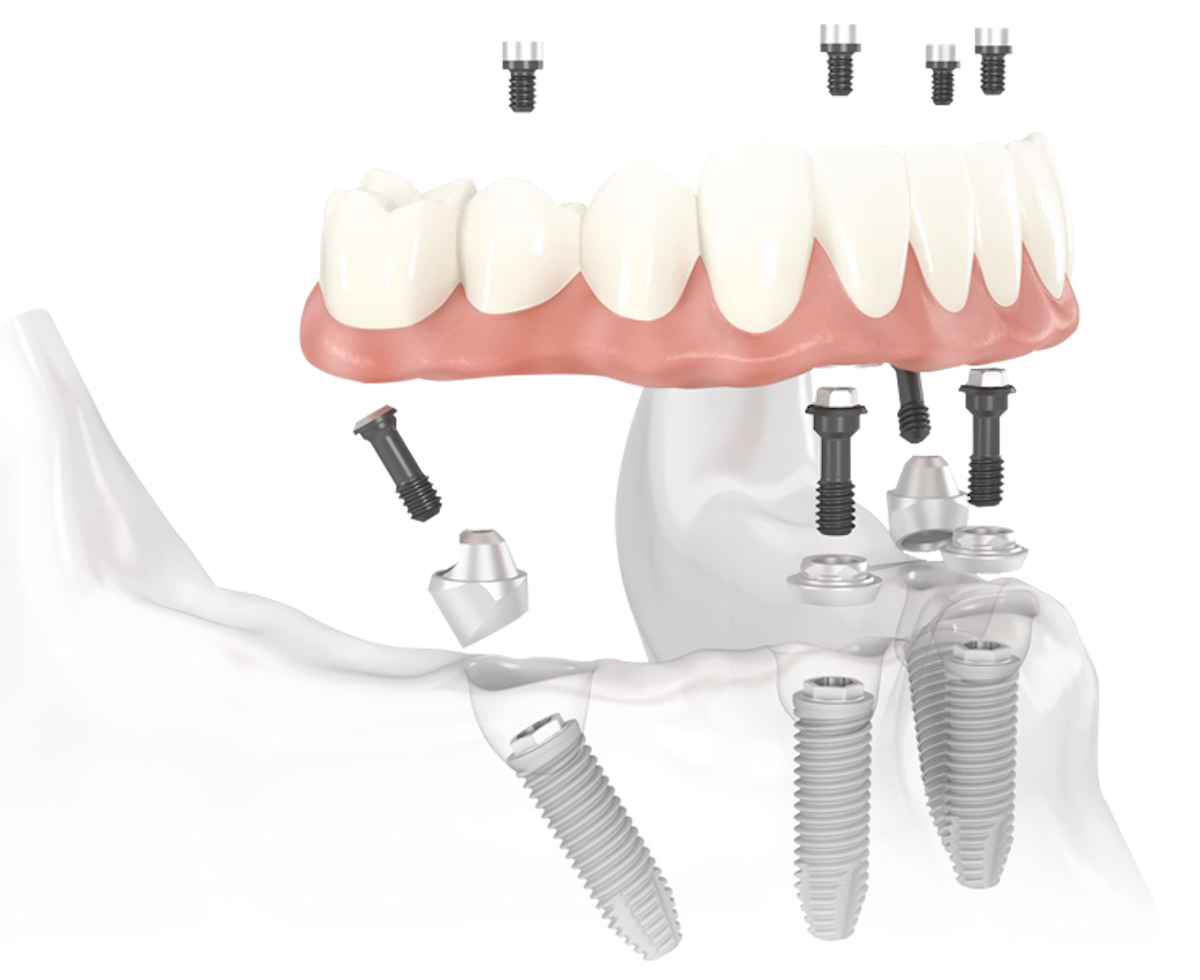
Types of Procedures
Whether a single tooth or a complete smile makeover, we have experience with all types of dental implants. Click the link to visit our page explaining the different types of dental implant procedures.
The Dental Implant Process.
Typically, the dental implant process if very straightforward. In order to evaluate the affected area and determine the ideal placement for implants an x-ray or CAT scan is necessary. Once we have this information, the surgeon will surgically place the implant(s) in your bone. Almost always you can immediately wear a temporary and you never have to be without teeth.
The implant will then fuse to the bone in approximately 10-12 weeks. After we are certain the implant is secure in the bone your general dentist will take molds to make a tooth or teeth that permanently cement on the implant(s). Different situations will dictate the exact steps needed but the good news is with the technology and surgical procedures available today everyone can replace teeth permanently.
Replacing a Single Tooth with An Implant.
If you are missing a single tooth, one implant and crown can replace it. A dental implant will provide a stable replacement without needlessly damaging adjacent teeth.
The advantages of a single tooth implant over old-fashioned bridgework are numerous. In addition to looking and functioning like a natural tooth, a dental implant replaces a single tooth without sacrificing the health of the neighboring teeth. The other common treatment for the loss of a single tooth, a tooth-supported bridge, requires that adjacent teeth be ground down to support the cemented bridge.
Because a dental implant will replace your tooth root, the bone is better preserved. With a bridge, some of the bone that previously surrounded the tooth begins to absorb (deteriorate). Dental implants integrate with your jawbone, fooling the bone into thinking a tooth still resides and thus keeps the bone healthy and intact.
In the long term, a single implant can be more esthetic and easier to keep clean than a bridge. Gums can recede around a bridge, leaving a visible defect when the metal base or collar of the bridge becomes exposed (especially evident in the front of your mouth!). Resorbed bone beneath the bridge can lead to a very unattractive smile. The cement holding the bridge in place can wash out allowing bacteria to decay the teeth that anchor the bridge. Most bridges are replaced due to recurrent decay as flossing is very difficult around bridgework.
Most often you will be able to wear a temporary during the healing phase of the implant procedure. Post-operative instructions specific to you will be given and should be strictly adhered to. Implants are extremely successful but small precautions are always taken to ensure the success of your therapy. Most patients tell us the most difficult part of the procedure is waiting the 90-180 days it takes for the implant to bond to the bone before the dentist can custom make a crown that permanently cements to the implant abutment which is screwed into the implant.

Replacing Several Teeth with Implants.
If you are missing several teeth, implant-supported bridges can replace them. Dental implants are the clear choice and provide several advantages over other teeth replacements. In addition to looking and functioning like natural teeth, implant-supported bridges replace teeth without support from adjacent natural teeth. Other common treatments for the loss of several teeth, such as fixed bridges or removable partial dentures, are dependent on support from adjacent teeth.
In addition, because implant-supported bridges will replace some of your tooth roots, your bone is better preserved. With a fixed bridge or removable partial denture, the bone that previously surrounded the tooth root may begin to resorb (deteriorate). Dental implants integrate with your jawbone, helping to keep the bone healthy and intact.
In the long term, implants are esthetic, functional and comfortable. Gums and bone can recede around a fixed bridge or removable partial denture, leaving a visible defect or causing extreme discomfort as your bone changes. Resorbed bone beneath bridges or removable partial dentures can lead to a collapsed, unattractive smile. The clasps found on most removable partial dentures also pull and push on the supporting teeth causing extensive damage to the teeth and bone. Removable partial dentures are also notoriously loose causing them to move around in your mouth and reduce your ability to talk and eat certain foods.
TeethXpress: The Modern Standard for Replacing all Missing Teeth.
If you have lost all your teeth, unsecured, traditional dentures are a solution which in many cases has limited success. At times, painful, inconvenient and unstable, such dentures can make chewing foods difficult, which could stop you from eating many of the foods you once enjoyed. However, modern dentistry has solutions to suit a variety of needs. The TeethXpress treatment option is one such solution.
The TeethXpress treatment concept replaces your missing teeth with a full dental bridge supported by only four dental implants. With fewer implants needed, overall treatment time is reduced. The unique All-on-4 solution also ensures greater stability in the bone, reducing the need for bone graft surgery to increase bone volume.
Typically, your dentist can place temporary provisional teeth on the same day after treatment. These provisional teeth look and feel much like natural teeth, and you can lead a normal life immediately after surgery. After approximately six months of healing time, your dentist will place your final bridge.
Your quality of life will improve, and you can start enjoying your favorite foods and activities again without the fear of loose or unsightly teeth.


